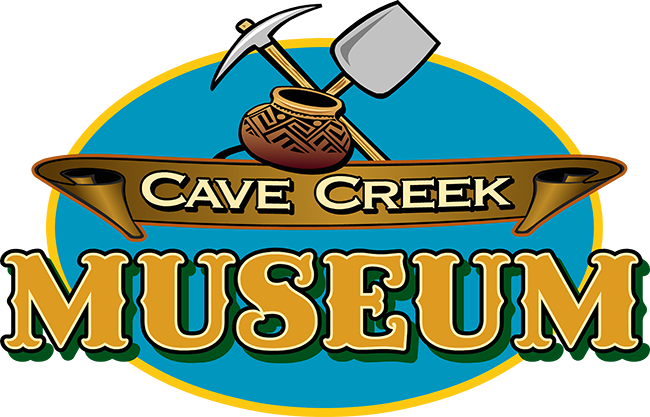DUDE RANCHES OF CAVE CREEK
Rancho Manana
Romaine “Romy” Lowdermilk, was called the Father of Dude Ranching in AZ. Romy was a real working cowboy, musician, singer, composer of western music, teller of tall tales, and published western short stories. Romy and his wife, Jean, acquired the old Howard Ranch in Cave Creek in the early 1940s and renamed it Rancho Manana.
Rancho Manana operated as a working cattle ranch until 1945 when Edward, “Ted”, and China Loring bought the property from the Lowdermilks with plans to turn it into a guest ranch. The Lowdermilks were offered a 50% interest in the ranch in return for managing it. While Rancho Manana was being built, the Lorings lived in cabins at Spur Cross; China would drive their young sons Edward, “Teddy”, and John to the Cave Creek one-room schoolhouse until the ranch was completed in 1946.
The guest ranch featured a modern, spring-fed swimming pool, horseback riding, cookouts and exploring nearby Indian ruins, pottery shards and petroglyphs. Evenings brought a special treat in the form of Romy’s music, tall tales, and quick wit.
Following the departure of the Lowdermilks in 1947, the Lorings operated the dude ranch with assistance of hired managers. When the guest ranch closed in the mid-1950s, the Rancho Manana land was sold for development of homes and condominiums during the 1970s.
Sierra Vista Ranch
In 1938, Francis and Betty Mognett acquired 229 acres of land on Continental Mountain which included a mining camp, spring, orchard, and garden. The Mognetts named their property Sierra Vista, built guests cottages, acquired riding horses, and began operating a small dude ranch. It was still difficult to attract customers to remote Cave Creek, and the Mognetts soon sold out to others. In 1952, Robert and Donna Fay Blomquist bought the property, added 80 additional acres of land and established a fairly successful combined dude ranch and cattle operation.
The ranch was sold in 1955 to Dr. John Owen and his wife, Jean. With money to invest, as well as good contacts in the East to keep their cottages full, they put in a spring-fed swimming pool and scraped out a landing strip on the side of side of Continental Mountain for guests who wished to fly their own planes to Cave Creek.
Surrounded by thousands of acres of the Tonto National Forest, the charming guest ranch offered accommodations for 15 guests. Although small, it offered everything that could be desired in the way of healthy recreation and enjoyment: A swimming pool filled by a never-failing spring, shuffleboard, badminton, horseshoe pitching, excellent saddle horses with guides who knew the country; milk, butter and eggs from the ranch; and outdoor BBQs and steak fries. This was one ranch where the real western hospitality prevailed and the guest was boss.
Doc Owens enjoyed collecting rocks – many of his rocks are in the Cave Creek Museum today.
When the Owns retired in 1962, they made Sierra Vista their permanent residence and closed down guest operations. Over the next few years, they sold all but a few acres of their land for new homes. After the death of her husband, Jean sold the remaining property. Sierra Vista was perhaps the most successful of all Cave Creek guest ranches.
Spur Cross Ranch
One of the oldest ranches in Arizona, the Spur Cross Ranch was spread over 1760 acres of beautiful territory at a 2650’ altitude. Spur Cross was a cattle ranch in desert and mountain country where horseback riding was the principal pastime.
The guest ranch began under very unusual circumstances in 1928: Owners Ed Joyce and Phil Lewis had become acquainted in the state penitentiary. When they were released from prison, they decided to go into the guest ranch business together. Lewis and Joyce located their new enterprise on a beautiful tract of hilly terrain five miles north of the little settlement of Cave Creek. The land adjoined the Tonto National Forest and straddled both the stream of Cave Creek and Spur Cross Road. Joyce, an experienced dude rancher, was called “Cap” or “Cap’n” from his military service in WWI.
Built to entice city-weary Easterners to pay hefty prices for a vacation spent riding the ranch with a real Cowboy, guests found their way to the isolated ranch: they were truly in the outback, with no electricity or telephones. Their main diversions were riding and enjoying the wilderness.
As other guest ranches broke ground throughout Arizona, Spur Cross Ranch’s meager facilities could not accommodate enough guests to make the place viable. Eventually, Lewis and Joyce sold the ranch to Warren Beaubien and his wife, Billie, who along with their six children, moved from Phoenix to the ranch.
The Beaubiens offered clean, “ranchy cabins with housekeeping facilities”. The Beaubien’s added many amenities, including the annual Christmas parties. One of the children remembered that during their first year on the ranch, their father killed about 29 rattlesnakes.
When the ranch was sold again, Spur Cross ceased to be a guest ranch. The new owners demolished the buildings and the land became cattle range for a while. When development of Spur Cross Ranch threatened the area, local citizens took action to preserve the pristine open space. Through their diligent efforts, Spur Cross Conservation Area is respected for its archeology sites, history, quiet trails, and amazing views.

